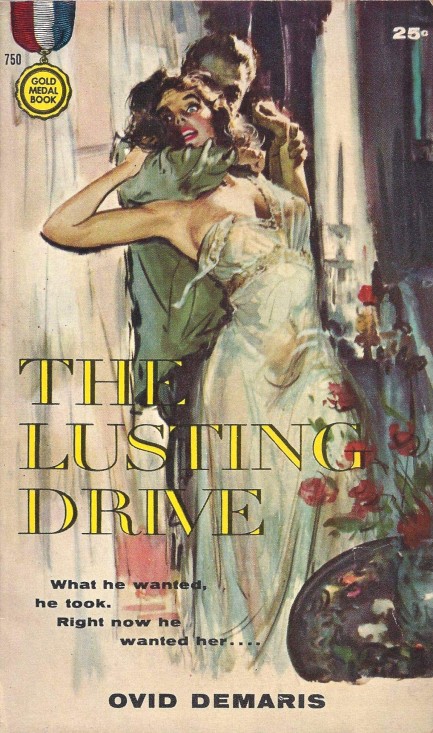 Binger understates the obvious. 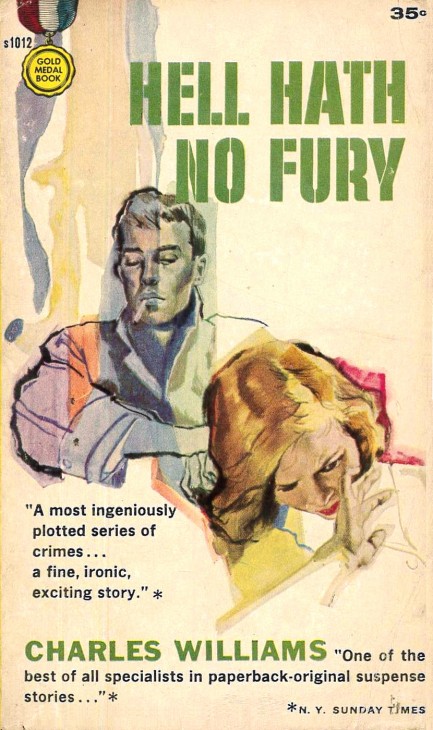
Above: a 1960 cover from Gold Medal Books for Hell Hath No Fury by Charles Williams. This was painted by Charles Binger and it's a beautifully simple watercolor composition, a very different approach from the almost fiery 1953 Barye Phillips cover. Of course, there's a good possibility that this is a random Binger not actually inspired by the book, but if so it's still interesting that Gold Medal would choose it. This is a reminder to track down more of Binger's work, and it's also a reminder that we're overdue to read another Williams. The cover says he was, “one of the best of all specialists in paperback-original suspense stories,” and it's true.
 It's the year 11,959 and everything is screwed worse than ever. 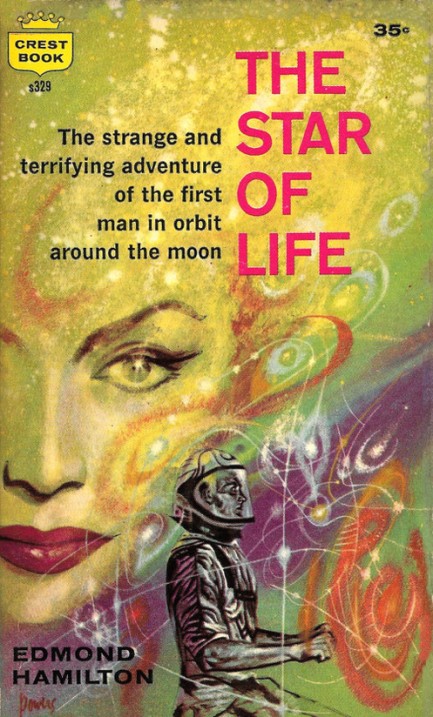
We thought we'd hit the sci-fi genre, since it's been a while, and chose Edmond Hamilton's Star of Life. It's one of the books visible in the photo of a 1959 airport paperback rack we showed you in August. The story concerns an astronaut named Kirk Hammond whose lunar capsule goes off course toward the far reaches of the solar system. Hammond decides to end his life rather than starve in the void, and when he vents the capsule the absolute cold of space freezes him. He awakens in the hot spacecraft hurtling back toward Earth. Turns out he was frozen so rapidly that his cells sustained no damage, and re-entry has thawed and revived him.
He's thrilled to be alive, but when he lands he's stunned to learn he's made a long elliptical orbit through the solar system and returned to Earth 10,000 years after he left. He's immediately caught in the middle of a millennia-old conflict between two races—the Vramen, immortal humanoids who control all galactic space, and the Hoomen, descended from ancient humans, and imprisoned on Earth. At least that's how it all sets up at first. Revelations are in the offing. Hammond is rescued by the Hoomen, but the Vramen have seen the capsule arrive, and their search for this strange object sends Hoomen-Vramen tensions into overdrive, while Hammond himself, as a being 10,000 years old, has the potential to permanently alter the balance of power.
Star of Life has some big concepts and it's spread over a galactic backdrop, but like a lot of science fiction, it's written at basically a junior high level. We had to laugh when one of the characters dropped the nugget: “We made an hypothetical reconstruction.” Here's an helpful hint for Hamilton and his editors. Don't teach your impressionable young readers to talk like knobs. It's not good for them. Still, the book is entertaining—utterly weightless, mind you, but fun in an awkward, haven't-gotten-laid yet sort of way. This Crest edition is from 1959 and the psychedelic cover art is by Richard Powers. Now back to our regularly scheduled grown people fiction.

 The mob comes to California and spreads like a virus. 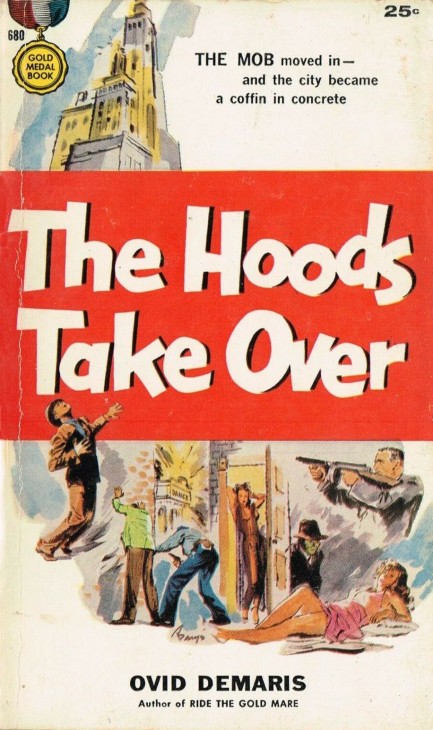
Above you see a piece of atypical Barye Phillips art on the cover of the 1957 crime thriller The Hoods Take Over, written by Ovid Demaris. We call it atypical because Phillips rarely painted in collage style, with multiple figures and elements crowded onto a canvas. In fact, this is the first we've seen of this technique from him, though we wouldn't be surprised if there are others. Working in this way, Phillips' beautiful visual style is simplified to the level of comic book art. We think it diminishes his genius, but hey, we bet it paid just as well as his other covers.
Turning to the story here, the title is perfectly descriptive—organized crime hoods are taking over L.A. But the overmatched cops are given a tool to check the rampant spread of lawlessness when a school teacher witnesses a brutal mob murder and—shockingly—is willing to testify even though it endangers his life. This is an excellent tale with a modern feel and pacing, told in numerous short chapters, and starring an array of characters. It hits the ground running, maintains a strong sense of dread, and never lets the tension abate.
We won't get into the plot too much except to say that we love novels where survivability for the good guys isn't guaranteed, and here you are in no way assured that the protagonists—embodied by that proud but possibly foolish teacher—will win. Will he stick to his principles when the mob comes a-knocking, threatening him and his pregnant wife? Most people wouldn't, but this particular citizen thinks he can make a difference. Because he never fought in World War II he believes the challenge now before him is how he's meant to contribute to the world's hard-won freedom.
The Hoods Take Over isn't a perfect novel. For one thing, its violent and messy ending is a shade on the improbable side, possibly conceived because Demaris felt it was the only way to conclude all his disparate character arcs in economical fashion. But unlikely or not, it's a slam-bang climax, and the book is very good overall. So good, in fact, that we immediately went online and located a couple more Demaris novels, and went way above our usual price ceiling for paperbacks to buy them. Guess we've come down with a bad case of Ovid.
 Errol Flynn takes readers back to the romantic South Seas of his youth. 
Above you see a cover for Showdown, which is a terrible name for this novel. It's evocative of nothing, a failing that's particularly egregious considering the story is set in the exotic South Seas. You may not have known that Errol Flynn was a novelist, but indeed he was, writing this and Beam Ends, plus his autobiography My Wicked, Wicked Ways, which you can consider fiction due to all the sticky episodes from his life it omits. Flynn was the equal of most popular fiction authors of his era, possibly even better than most, however Showdown, besides a better title, could have used an edit for conciseness in the first half. He goes into what we feel is unneeded detail into secondary characters, but even so, everything he writes is confident and steeped in tropical atmosphere.
In the tale, a British boat captain named Shamus O'Thames plies the waters around New Guinea, falls in love with a nun named Granice, and eventually takes on a charter of Hollywood types shooting second unit footage for a movie. It's an ill-advised trip, but he agrees to it mainly because it will take him near his nun's isolated jungle mission. Of course the voyage aboard his boat Maski does not go as planned, as the group end up stranded in headhunter territory. We could offer more details, but we don't want to spoil it for interested readers. We'll just say that it's a fantastic tale with unexpected turns, some of them hard to believe, but with the whole lent credibility by the fact that Flynn, who was from Tasmania, had numerous real life adventures in New Guinea before he became a star.
Showdown probably couldn't be published today due to its casting of native New Guinean people, known as Papuans or sometimes Melanesians, as either loyal servants or depraved villains. The book was originally published in 1946, a time when most white men didn't think of native peoples as owners of their own land, nor deserving of self determination. It's difficult to know exactly how Flynn himself felt about colonialism. We suspect, based on the narrative, that he might not have been entirely on the side of the forces of so-called civilization, but we'd have to re-read his autobiography to know for sure, and that book, sadly, vanished somewhere into the heart of darkness during one of our international moves. Flynn's adventurer O'Thames is certainly kinder than most, but can't be called enlightened by any stretch.
Anyway, Showdown is worth reading, bad title and all (by the way, we totally get the inference of a showdown not only between characters, but between cultures—it's still a bad title). Flynn covers land and sea, love and hate, race and racism (however inadequately), and ultimately, like other authors in this sub-genre (see here and here), asks whether white men should be in the tropics at all. He doesn't have any new answers, but he certainly says what he wants to with some style and an abundance of conviction. He was open about the fact that he preferred being a novelist over being an actor. His personal foibles and failings aside, it's too bad he didn't write more.
 I know it isn't exactly Tahiti, baby, but it's warm, cheap, and there aren't any COVID restrictions. 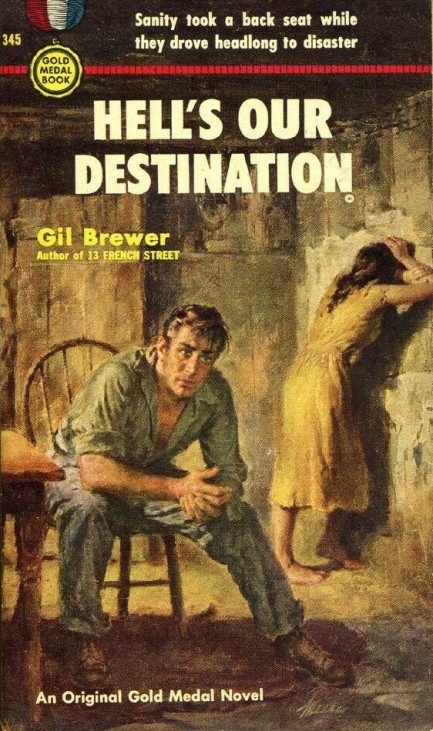
We're fans of illustrator James Meese. His covers are easy to caption. Remember Fort Everglades? How about Amazon Head-Hunters? We don't know if credit goes to him for the interesting moments his chose for his work, or if the publishers who employed him were responsible, but we'll take it. Above is another—Gil Brewer's 1953 novel Hell's Our Destination, with a couple who look like they've just realized their non-refundable AirBnB is right over a country/western dance bar that stays open until sunrise.
 These shots are surprisingly revealing. This shaving thing you do—call me crazy but I think that could really catch on. 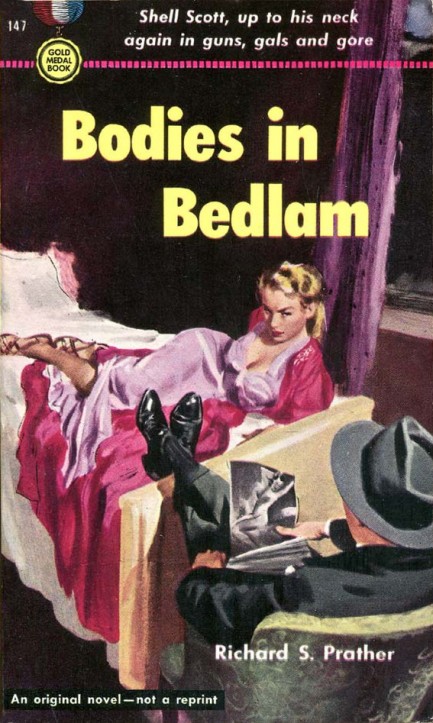
Above, a Barye Phillips cover for Bodies in Bedlam by Richard S. Prather, the second entry in his forty-one novel series (or maybe it was forty-two) starring detective Shell Scott, for Gold Medal Books, 1951. We have a couple, so we'll circle back to Prather and Mr. Scott a bit later.
 When ragtag crooks hook up with a bevy of Bahama mamas a tropical storm breaks. 
Basil Heatter 1963's novel Virgin Cay was an enjoyable tale, so when we saw this Robert McGinnis cover for Harry and the Bikini Bandits we couldn't resist. The novel, which came in 1969 with Fawcett/Gold Medal's edition appearing in 1971, is the story of seventeen-year-old Clayton Bullmore's trip to the Bahamas to see his nutty uncle Harry, who lives on a raggedy ketch and has a magic touch with women of all types. This is where the bikinis come in, but the bikini-wearers are not the bandits (except, technically, one). The bandits are Harry, a couple of his acquaintances, and Clay, who's dragged into a scheme to rob the big casino in Nassau. The combination of coming-of-age story and casino caper is fun, and Heatter mixes in humor, sex, and action, and folds it all into a winning waterborne milieu. He even manages to add a shipwreck, a deserted island, and buried treasure, so we'd say he includes all the most beloved tropes of tropical adventures. It'll make you want to run away to the Caribbean. Heatter is two-for-two in our ledger.
 Everybody's gotta go sometime. 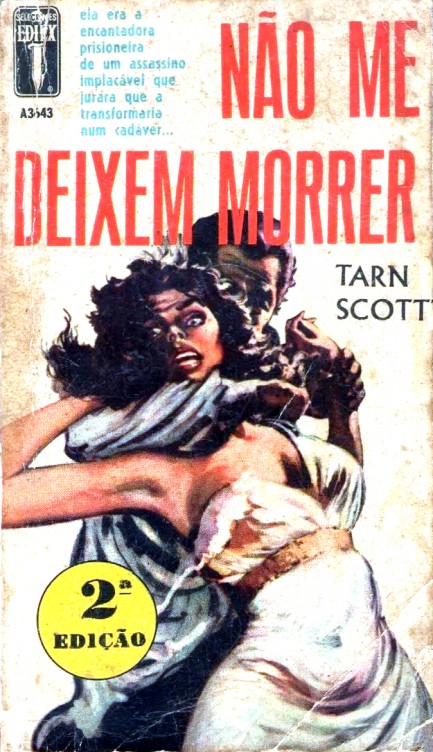
We don't find much Brazilian pulp, but above is an interesting—if battered—cover for Tarn Scott's, aka Walter Szot and Peter G. Tarnor's Não Me Deixem Morrer, which is a translation of their U.S. released 1957 kidnapping tale Don't Let Her Die, a book we read and enjoyed a few years ago. This was put out by the Rio de Janeiro based imprint Ediex for its Selecrimes series in 1964. We gather that Ediex was a branch of the Mexico City publisher Editormex Mexicana, and that the company released quite a few translations of English crime books during the 1960s.
The art, which is by an unknown, is a low rent copy of that found on the cover of 1958's The Lusting Drive by Ovid Demaris, which you see below. That cover is also uncredited, but some think it's by Ernest Chiriacka. We agree. In fact, we don't think there's any doubt. Not only is the style—particularly of the female face—a dead match, but Chiriacka was pumping out illos by the cartload for Gold Medal during the mid- to late-1950s. So we're going to go ahead and call this one a lock. We may share a few more Brazilian paperback covers in a bit. Stay tuned.
 The Devil went down to Southeast Asia looking for fortunes to steal. 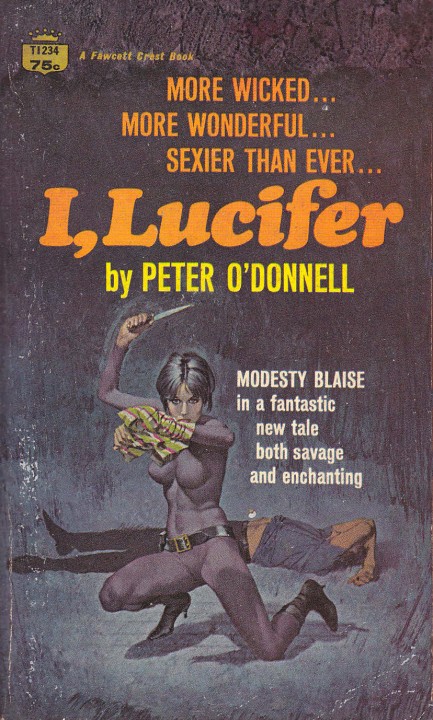
1969's I, Lucifer is Peter O'Donnell's third Modesty Blaise novel, and it's a series we're going through mainly to highlight the great cover art by Robert McGinnis. He didn't illustrate all the books. In fact, this might be the last, which means we'll probably move on to other authors. But that won't be because the Blaise books aren't good. In fact, for the sexy spy genre they're top notch—exotically located, compellingly plotted, and peopled by wacky Bond-style supervillains. Case in point: the titular character in I, Lucifer is a man suffering from a psychotic delusion that he's Satan. The funny part is he isn't evil. The real evil guy is Seff, the opportunist who launches a global extortion scheme that hinges on faux-Lucifer's participation even though his delusion prevents him having a clue what he's really doing. Lucifer might be the only villain we've encountered in a novel who's a victim.
When Seff's murderous extortion hits too close to home for Modesty, she and sidekick Willie Garvin gear up and eventually end up in the Philippines, where they right some wrongs, explosively. As usual Modesty uses sex to get over on the bad guys, and it's a major part of what readers enjoyed about the series. At one point she ponders whether a colleague thinks she's promiscuous. Well, no, she isn't by 1969 standards. But the joy of literature is she can be unpromiscuous, yet we can be there in the room for every one of her widely spaced encounters. This book is particularly amusing along those lines, as it brings two of Modesty's lovers together to be uncomfortable and/or jealous as they're displaced by a third. But sleaze fans will need to look elsewhere. O'Donnell is subtle—if not poetic—with his sex scenes.
Though the sexual aspects of Modesty Blaise were a major attraction of the novels, we enjoy even more the tactical nature of O'Donnell's action, which is probably an influence from his military service in Iran, Syria, Egypt, Greece and other places. It's also probably why so much of the Blaise series is connected to that region. While the tales are always exotic, this entry is even wilder than usual. How wild? It involves precognition, trained dolphins, Moro mercenaries, and body implants that kill remotely, yet it all works. That's because as always, in the center of the chaos, you have Blaise and Garvin, perfect friends, platonic soulmates, and two armed and extremely deadly halves of a razor sharp fighting machine. Abandon all hope ye who cross them.
 Yup, that's them, but do they have to go to jail? I felt like they brought a real touch of class to skid row. 
A line-up of women at the mercy of a witness and the police? You know this isn't going to end well. Angels in the Gutter is classic scare fiction (i.e. if you're not careful this could happen to someone you know—or even you!) originally published in 1955 by Fawcett Publications for its Gold Medal line, with this second printing coming in 1959. We really should have bought this book. It's cheap and there are no reviews online. That's the daily double for us. Plus the wraparound cover (below) is excellent. But we have about ten times as many books lined up as women lined up at this police station, and that's no exaggeration, so this one was a difficult pass. 
|
 |

The headlines that mattered yesteryear.
1926—Aimee Semple McPherson Disappears
In the U.S., Canadian born evangelist Aimee Semple McPherson disappears from Venice Beach, California in the middle of the afternoon. She is initially thought to have drowned, but on June 23, McPherson stumbles out of the desert in Agua Prieta, a Mexican town across the border from Douglas, Arizona, claiming to have been kidnapped, drugged, tortured and held for ransom in a shack by two people named Steve and Mexicali Rose. However, it soon becomes clear that McPherson's tale is fabricated, though to this day the reasons behind it remain unknown. 1964—Mods and Rockers Jailed After Riots
In Britain, scores of youths are jailed following a weekend of violent clashes between gangs of Mods and Rockers in Brighton and other south coast resorts. Mods listened to ska music and The Who, wore suits and rode Italian scooters, while Rockers listened to Elvis and Gene Vincent, and rode motorcycles. These differences triggered the violence. 1974—Police Raid SLA Headquarters
In the U.S., Los Angeles police raid the headquarters of the revolutionary group the Symbionese Liberation Army, resulting in the deaths of six members. The SLA had gained international notoriety by kidnapping nineteen-year old media heiress Patty Hearst from her Berkeley, California apartment, an act which precipitated her participation in an armed bank robbery. 1978—Charlie Chaplin's Missing Body Is Found
Eleven weeks after it was disinterred and stolen from a grave in Corsier near Lausanne, Switzerland, Charlie Chaplin's corpse is found by police. Two men—Roman Wardas, a 24-year-old Pole, and Gantscho Ganev, a 38-year-old Bulgarian—are convicted in December of stealing the coffin and trying to extort £400,000 from the Chaplin family. 1918—U.S. Congress Passes the Sedition Act
In the U.S., Congress passes a set of amendments to the Espionage Act called the Sedition Act, which makes "disloyal, profane, scurrilous, or abusive language" about the United States government, its flag, or its armed forces, as well as language that causes foreigners to view the American government or its institutions with contempt, an imprisonable offense. The Act specifically applies only during times of war, but later is pushed by politicians as a possible peacetime law, specifically to prevent political uprisings in African-American communities. But the Act is never extended and is repealed entirely in 1920.
|

|
|

It's easy. We have an uploader that makes it a snap. Use it to submit your art, text, header, and subhead. Your post can be funny, serious, or anything in between, as long as it's vintage pulp. You'll get a byline and experience the fleeting pride of free authorship. We'll edit your post for typos, but the rest is up to you. Click here to give us your best shot.

|
|

















